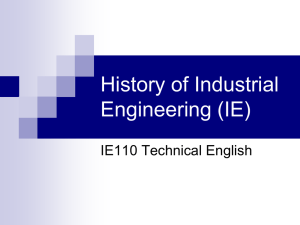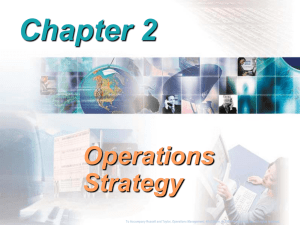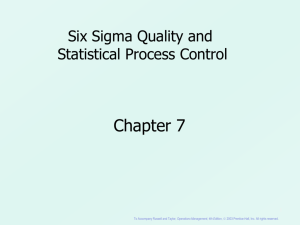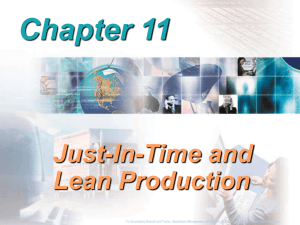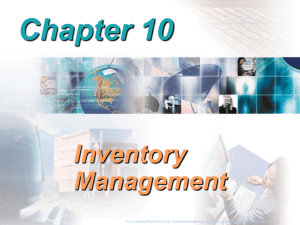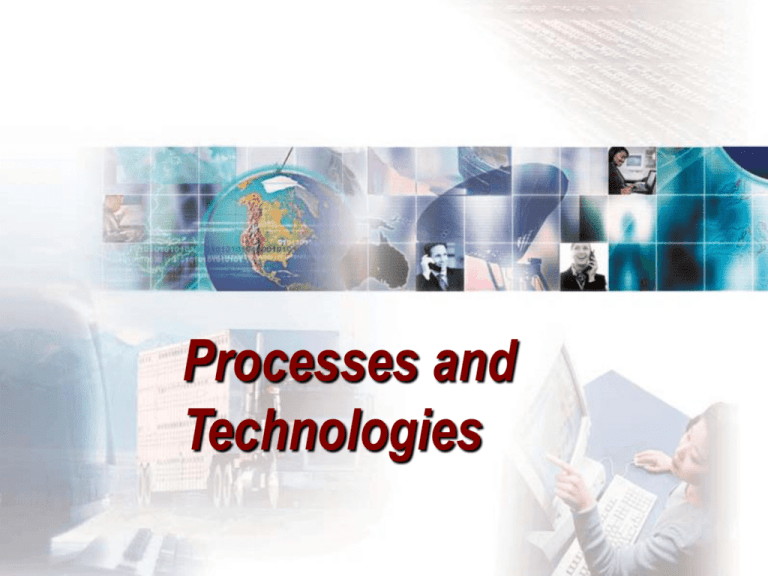
Processes and
Technologies
Process (Definition of)
Process: Any part of an organization that takes inputs and
transforms them into outputs
Process Flowcharting (definition of)
• Process flowcharting is the use of a diagram to present
the major elements of a process
• The basic elements can include tasks or operations,
flows of materials or customers, decision points and
storage areas or queues
• It is an ideal methodology by which to begin analyzing a
process
Flowchart Symbols (1 of 2)
Tasks or operations
Decision Points
Examples: Giving an
admission ticket to a
customer, installing an
engine in a car, etc.
Examples: How much
change should be
offered to a customer,
which tool should be
used, etc.
Flowchart Symbols (2 of 2)
Storage areas or
queues
Examples: Sheds, lines
of people waiting for a
service, etc.
Flows of
materials or
customers
Examples: Customers
moving to a seat,
mechanic getting a tool,
etc.
Example 1: Flowchart of Student Going to
School
Go to
school
today?
No
Goof
off
Yes
Drive to
school
Walk to
class
Example 2: Flowchart for Inspection
Process
Material
Received
from
Supplier
No,
Continue…
Inspect
Material for
Defects
Defects
found?
Yes
Return to
Supplier for
Credit
Processes
• Conversion (ex. Iron to steel)
• Fabrication (ex. Cloth to clothes)
• Assembly (ex. Parts to components)
• Testing (ex. For quality of products)
Process Selection
To Accompany Russell and Taylor, Operations Management, 4th Edition, 2003 Prentice-Hall, Inc. All rights reserved.
Process Selection
Process Selection: Deciding on the way
production of goods or services will be organized
Process selection can involve substantial
investment in
Equipment
Layout of facilities
Process Selection Has Major Implications
for:
•
•
•
•
Capacity planning
Layout of facilities
Equipment
Design of work systems
To Accompany Russell and Taylor, Operations Management, 4th Edition, 2003 Prentice-Hall, Inc. All rights reserved.
Process Selection and System Design
Forecasting
Capacity
Planning
Product and
Service Design
Technological
Change
Facilities and
Equipment
Layout
Process
Selection
Work
Design
To Accompany Russell and Taylor, Operations Management, 4th Edition, 2003 Prentice-Hall, Inc. All rights reserved.
Process Strategy
Process strategy defines the overall approach to
producing goods and services
Key Aspects of Process Strategy:
– Capital Intensity
• The mix of equipment and labor that will be used by the organization
– Process flexibility
• The degree to which the system can be adjusted to changes in
processing requirements due to such factors as
– Product and service design changes
– Volume changes
– Changes in technology
– Vertical integration
– Customer involvement
Factors that Affect Process Decisions
Required Variety,
Required Volume (how many)
Required Flexibility (degree of)
From Function to Process
Sales
Manufacturing
Purchasing
Accounting
Product Development
Order Fulfillment
Supply Chain Management
Customer Service
Function
Process
Process Selection
• Variety
– How much
• Flexibility
– What degree
• Volume
– Expected output
Job Shop
Batch
Repetitive
Continuous
Types of Processes
(Process Flow Structures)
Projects
Job shop
Batch production
Mass
production/assembly
(repetitive)
Continuous flow
production
Types of Processes (1 of 2)
Determine how to produce a product or provide a
service
Projects (nonroutine jobs)
Job shop
Small scale (e.g. copy center making a single copy of
a student term paper)
Batch
Moderate volume (e.g. copy center making 10,000
copies of an ad piece for a business)
Types of Processes (2 of 2)
Mass production/assembly
High volumes of standardized goods or services
(e.g. Automobile manufacturer)
Continuous Flow Line
Very high volumes of non-discrete goods (eg.
Petroleum manufacturer)
Types of Processing
To Accompany Russell and Taylor, Operations Management, 4th Edition, 2003 Prentice-Hall, Inc. All rights reserved.
Process Choice Effects
To Accompany Russell and Taylor, Operations Management, 4th Edition, 2003 Prentice-Hall, Inc. All rights reserved.
Types of Process Strategies
Process strategies follow a continuum
Within a given facility, several strategies may be used
Process Focused
(intermittent process)
Repetitive Focus
(assembly line)
Product Focused
(continuous process)
Continuum
High variety, low volume
Low utilization (5% - 25%)
General-purpose equipment
Modular
Flexible equipment
Low variety, high volume
High utilization (70% - 90%)
Specialized equipment
Process-Focused Strategy
Facilities are organized by process
Similar processes are together
Example: All drill presses are together
Low volume, high variety products
‘Jumbled’ flow
Other names
Intermittent process
Job shop
Batch
Product A
Operation
1
Product B
2
3
Process-Focused Strategy Examples
Bank
Hospital
© 1995 Corel Corp.
© 1995
Corel
Corp.
Machine
Shop
© 1995 Corel Corp.
Repetitive Focused Strategy
Facilities often organized by assembly lines
Characterized by modules
Parts & assemblies made previously
Modules combined for many output options
Other names
Assembly line
Production line
Repetitive-Focused Strategy - Examples
Fast
Food
Clothes
Dryer
McDonald’s
over 95 billion served
Truck
© 1995 Corel Corp.
© 1984-1994 T/Maker Co.
© 1995 Corel Corp.
Product-Focused Strategy
Facilities are organized by product
High volume, low variety products
Where found
Continuous process manufacturing
Other names
Flow line production
Continuous production
Products A & B
1
2
Operation
3
Product-Focused Examples
Soft Drinks
(Continuous,
then Discrete)
Light Bulbs
(Discrete)
© 1995 Corel
Corp.
© 1984-1994 T/Maker Co.
Paper (Continuous)
© 1995 Corel Corp.
Mass
Flu Shots
(Discrete)
© 1995 Corel Corp.
Product – Process Matrix
Dimension
Job shop
Batch
Repetitive
Continuous
Job variety
Very High
Moderate
Low
Very low
Process
flexibility
Very High
Moderate
Low
Very low
Unit cost
Very High
Moderate
Low
Very low
Volume of
output
Very Low
Low
High
Very High
Types of Processes
Product ………..
Customer……….
Demand………...
Volume………….
No. of different
products………
System…………..
Equipment……...
Type of work…..
Skills…………….
PROJECT
BATCH
MASS
CONTINUOUS
Unique
One-at-a-time
Infrequent
Very low
Made to order
Few individuals
Fluctuates
Low to med
Made to stock
Mass market
Stable
High
Commodity
Mass market
Very stable
Very high
Infinite
Long-term
Many, varied
Discrete, job
Few
Repetitive,
assembly lines
Special-purpose
Assembly
Limited range
of skills
Efficiency,
speed, low cost
Capital investment,
lack of
responsiveness
Autos, TV’s,
fast food
Very low
Process industry
Varied
Contracts
Experts,
craftspeople
Advantages……. Custom work,
technology
Dis- adv………… Nonrepetitive,
small customer
base, expensive
Example……….. Construction,
shipbuilding
General-purpose
Fabrication
Wide range
of skills
Flexibility,
quality
Costly, slow,
difficult to
manage
Machine shops,
printing, bakery
Highly automated
Mix, treat, refine
Equipment
monitors
Highly efficient
large capacity
Difficult to
change
Paint, chemicals,
food
Product-Process Matrix
To Accompany Russell and Taylor, Operations Management, 4th Edition, 2003 Prentice-Hall, Inc. All rights reserved.
Product and Service Profiling
• Process selection involves
– Substantial investment in equipment
– Has a very specific influence on layout
• Product or service profiling
– Linking key product or service requirements to process
capabilities
– Key dimensions relate to
• Range of products or services that will be processed
• Expected order sizes
• Pricing strategies
• Expected frequency of schedule changes
• Order-winning requirements
To Accompany Russell and Taylor, Operations Management, 4th Edition, 2003 Prentice-Hall, Inc. All rights reserved.
Transition From Product Design to
Process Design:
Product and Production Documents
Product Documents
• Engineering drawings
– Shows dimensions, tolerances, & materials
– Shows codes for Group Technology
• Assembly drawing
-- Shows exploded view of product
• Bill of Material
– Lists components, quantities & where used
– Shows product structure
Engineering Drawings - Show
Dimensions, Tolerances, etc.
Assembly Drawing
Head
Neck
Handle
End
Cap
Bill of Material Example
Bill of Material
P/N: 1000
Name: Bicycle
P/N
Desc
Qty
1001
Handle Bars
1
1002
Frame Assy
1
1003
Wheels
2
1004
Frame
1
Units Level
Each
1
Each
1
Each
2
Each
2
Process Flow Design
Process flow design can be defined as a mapping of
the specific processes that raw materials, parts, and
subassemblies follow as they move through a plant
Process Documents
Production Documents
Tools to conduct Process Flow Design
Assembly chart /
product structure diagram
Operations process chart
Routing sheet
Assembly Chart (Gozinto Chart)
Bottom bun
Beef patty
Salt
Cheese
SA
Lettuce
Sauce
Onions
First-layer assembly
Middle bun
Beef patty
Salt
Cheese
Lettuce
Sauce
Onions
Pickles
SA
Second-layer assembly
Sesame seed top bun
Wrapper
Completed Big Mac
Assembly Chart for
A Tuna Sandwich
1
Tuna Fish
SA1
2
3
Tuna
Assy
A1
Sandwich
Mayonnaise
Bread
FG
A2
Assembly Drawing and Assembly
Chart
Operations Process Chart
Part name
Crevice Tool
Part No.
52074
Usage
Hand-Vac
Assembly No. 520
Oper. No. Description
Dept.
Machine/Tools
Time
10
Pour in plastic bits
041
Injection molding
2 min
20
Insert mold
041
#076
2 min
30
Check settings
& start machine
041
113, 67, 650
20 min
40
Collect parts & lay flat
051
Plastics finishing
10 min
50
Remove & clean mold
042
Parts washer
15 min
60
Break off rough edges
051
Plastics finishing
10 min
Route Sheet
Lists all operations
Route Sheet for Bracket
Sequence
Machine
Operation
1
Shear # 3
2
Shear # 3
3
Drill
press
Brake
press
Shear to
length
Shear 45°
corners
Drill both
holes
Bend 90°
4
Setup
Time
5
Operation
Time/Unit
.030
8
.050
15
3.000
10
.025
Process Analysis
The systematic examination of all aspects of a
process to improve its operation to make it:
Faster
More efficient
Less costly
More responsive
Basic tools
Process flowchart
Process diagrams
Process maps
Process Flowchart Symbols
Operations
Inspection
Transportation
Delay
Storage
Process Flowchart: Example 1
SUBJECT: Request tool purchase
Dist (ft)
Time (min)
Symbol
Description
D Write order
D On desk
75
D To buyer
D Examine
= Operation; = Transport; = Inspect;
D = Delay; = Storage
Process Flow Chart: Example 2: Hamburger Assembly
Dist.
(Ft)
1.5
1.0
.5
.5
Time
(Mins)
.05
2.50
.05
.05
.15
.10
.20
.05
Chart
Symbols
Process Description
Meat Patty in Storage
Transfer to Broiler
Broiler
Visual Inspection
Transfer to Rack
Temporary Storage
Obtain Buns, Lettuce, etc.
Assemble Order
Place in Finish Rack
3.5
3.15
TOTALS
2 =4 Operation
1 - 2
Value-added time
time/Total time =
(2.50+.20)/3.15=85.7%
Process Flowchart: Example 3
Description
of
process
1
Unload apples from truck
2
Move to inspection station
3
Weigh, inspect, sort
4
Move to storage
5
Wait until needed
6
Move to peeler
7
Apples peeled and cored
15
8
Soak in water until needed
20
9
Place in conveyor
5
10
Move to mixing area
11
Weigh, inspect, sort
Page 1 0f 3
Total
Distance
(feet)
Location: Graves Mountain
Process: Apple Sauce
Time
(min)
Operation
Transport
Inspect
Delay
Storage
Step
Date: 9-30-02
Analyst: TLR
20
100 ft
30
50 ft
360
20 ft
20 ft
30
480
190 ft
Process Diagram
UPS
Active
Bins
Receiving
Reserve
Storage
Picking
Packing
Monogramming
Embroidering
Quality
Assurance
Back to
Vendor
Hemming
Gift
Boxing
Shipping
Parcel
Post
Next-Day
UPS
Process Map
Customer
Waiter
Place order
Is order
complete?
Salad Chef
Dinner Chef
N
Y
Give soup or salad order to chef
Prepare soup or
salad order
Prepare dinner
order
Give dinner order to chef
Drink
Get drinks for customer
Eat salad or
soup
Deliver salad or soup order to customer
Eat dinner
Deliver dinner to customer
Receives check
Deliver check to customer
Gives payment
to waiter
Receive payment for meal
Cash or
Credit?
Credit
Cash
Collect change,
leave tip
Bring change to customer
Run credit card through
Fill in tip
amount
Return credit slip to customer
Collect tip
Give order
to waiter
Give order
to waiter
Service Process Design
Customer Interaction and Process
Strategy
Low
High
Mass Service
Personal
banking
Commercial
Banking
Full-service
stockbroker
Boutiques
Retailing
Service Factory
Law clinics
Fast food
restaurants
Warehouse and
catalog stores
Service Shop
For-profit
hospitals
Fine dining
restaurants
Airlines
Degree of Interaction and Customization
Hospitals
Low
Limited service
stockbroker
No frills
airlines
General purpose
law firms
High
Degree of Labor Intensity
Professional Service
Techniques for Improving Service Productivity
(1 of 2)
Strategy
• Separation
• Self-service
• Postponement
• Focus
Technique
• Structure service so customers
must go where service is offered
• Self-service so customers
examine, compare and evaluate
at their own pace
• Customizing at delivery
• Restricting the offerings
Techniques for Improving Service
Productivity (2 of 2)
• Modules
• Modular selection of service.
Modular production
• Automation
• Separating services that lend
themselves to automation
• Precise personnel scheduling
• Clarifying the service options
• Explaining problems
• Improving employee flexibility
• Scheduling
• Training
More Opportunities to Improve Service
Processes
Methods
Layout
Human Resource
Technology
Technologies
Technology
Technology: The application of scientific discoveries to
the development and improvement of products and
services and operations processes.
Technology innovation: The discovery and
development of new or improved products, services, or
processes for producing or providing them.
Kinds of Technology
Operations management is primarily concerned with three
kinds of technology:
– Product and service technology
• Discovery and development of new products and services
– Process technology
• Methods, procedures, and equipment used to produce goods and
provide services
– Information technology
• The science and use of computers and other electronic equipment to
store, process, and send information
All three have a major impact on:
Costs
Productivity
Competitiveness
Technology for Competitive Advantage
Technological advances can lead to competitive advantage
– Product technology
• Increased market share and profits
– Processing technology
• Improved quality
• Lower costs
• Higher productivity
• Expanded processing capabilities
To Accompany Russell and Taylor, Operations Management, 4th Edition, 2003 Prentice-Hall, Inc. All rights reserved.
Technology as a Competitive Advantage
Innovations in
Products and services
Cell phones
PDAs
Wireless computing
Processing technology
Increasing productivity
Increasing quality
Lowering costs
Eases flexibility
Technology Acquisition
Technology can have benefits but …
Technology risks include:
What technology will and will not do
Technical issues
Economic issues
Initial costs, space, cash flow, maintenance
Consultants and/or skilled employees
Integration cost, time resources
Training, safety, job loss
Technology Acquisition
Advantages:
Increased precision (less variability)
Increased productivity
Increased flexibility, increased product variety
Decreased cost (labor, material, inventory, transportation
and quality costs)
Improved product features and quality
Decreased pollution
Decreased size
Decreased power requirements.
Process Technology: Automation
Machinery that has sensing and control devices that
enables it to operate automatically
Fixed automation
Programmable automation
Flexible automation
Automation Questions
1.
2.
3.
4.
5.
6.
What level of automation is appropriate?
How would automation affect system flexibility?
How can automation projects be justified?
How should changes be managed?
What are the risks of automating?
What are the likely effects of automating on:
– Market share
– Costs
– Quality
– Customer satisfaction
– Labor relations
– Ongoing operations
To Accompany Russell and Taylor, Operations Management, 4th Edition, 2003 Prentice-Hall, Inc. All rights reserved.
Manufacturing Hardware Technology
Numerically controlled (NC) machines
Controlled by punched tape
Computer numerical controlled (CNC)
Controlled by attached computer
Direct numerical control (DNC)
Several NC machines controlled by single computer
Robotics
Flexible manufacturing systems (FMS)
Includes automated material handling
Robotics
Programmable manipulators
Follow specified path
Better than humans with respect to
Hostile environments
Long hours
Consistency
Adoption has been slowed by
ineffective integration and
adaptation of systems
Hardware Technology: Automated Material
Handling
Conveyors
Automated guided vehicle
(AGV)
Automated storage &
retrieval system (ASRS)
Flexible Manufacturing System
CNC
Machine
Finished
goods
Computer
control
room
Terminal
Pallet
Automatic
tool changer
CNC
Machine
Parts
Manufacturing Software Technology
Computer Aided Design and Computer Aided
Manufacturing (CAD/CAM)
Computer Integrated Manufacturing (CIM)

